NEGenWeb Project
Church/Catholic
Franciscans
![]()
![]()
![]() NEBRASKA AS A SISTER STATE
NEBRASKA AS A SISTER STATE![]()
![]()
![]()
Chapter II
THE NEBRASKA TERRITORY
The political history of Nebraska is that of a typical Western Plains State. "Old Nebraska", as this territory was known in the Fifties, comprised almost five times the square miles now included in the State. It reached from the Missouri River and Minnesota west to the Rockies, and from Kansas north to the Canadian border.
THE FIRST NEBRASKA GOVERNOR
When Nebraska was made a Territory, President Franklin Pierce appointed Francis Burt Governor. With his secretary, Thomas Cuming, the Governor arrived in Omaha in 1854. Burt died within a month after he took office, whereupon Cuming took up leadership as Acting-Governor. He at once held an election, gathered about him, as best he could, a legislature representing the inhabitants and proceeded to create legal districts.
THE FIRST COUNTIES IN NEBRASKA
Eight counties were formed by Cuming's legislature, four on each side of the Platte River. Those on the north side were called Burt, in memory of the late Governor; Washington; Douglas, after Stephen A. Douglas, of the famous Lincoln-Douglas debates, who was Chairman of the Senate Territorial Committee; and Dodge, for Senator A. C. Dodge, of Iowa, who was first to introduce the Nebraska Territorial Bill in the Senate. The South counties were named Pierce, after the President; and Richardson, Cass and Forney, for three prominent early settlers.
Governor Cuming stretched his imagination considerably, when he sectioned the land not officially included in the eight counties mentioned above. He created "Jones County", which was to include all the land beyond the western boundary of Richardson County, which was sixty miles west of the Missouri River. This land was south of the Platte River and ran west to the Rocky Mountains, thus including a part of Wyoming and Colorado. Cuming sent one Jesse Lowe to inspect the new county, so that he might establish some sort of voting precincts. Lowe returned with a discouraging report. Not a single white soul had been seen in the weeks of travel, save a few poverty-stricken settlers, who, as he really thought, lived in Richardson County at that.
NEBRASKA'S STORY OF SLAVERY--
THE UNDERGROUND RAILROAD
During the embittered years just preceding the Civil War, when the questions of slavery and state's rights commanded the impassioned oratory of the nation's most talented men, the Nebraska Territory was thrown wide open to slavery by the decision of the famous Dred Scott case. Slaves never occupied a very prominent position in Nebraska; for most of the settlers were of the East and North, and hated slavery. Perhaps the most notorious slave-owner in Nebraska was S. F. Nuckolls, a wealthy landowner of Nebraska City, after whom Nuckolls County was named.
At the escape of one of Nuckoll's slaves, Eliza, an intensive search reaching into several states evidenced the fact that Eliza had been secretly passed from one place to another in Iowa by the system known as "the underground railroad". The slave was finally located in Chicago, and was about to be brought back, when a hasty escape into Canada saved her from extradition. Thereupon Nuckolls sued several Iowans whom he had reasons to believe had helped his slave make good her get away. The affair created much interest in the border states, but the firing upon Fort Sumter occurred shortly after. People forgot the incident in the face of the hovering civil war, and the case was never brought to court.
A WORD ON NEBRASKA'S GOVERNORS
The story of Nebraska's governors shows, as no other record does, some of the romance entwined in the development after the Territory became a state in 1867. One of these, probably the most picturesque, was General John M. Thayer, already alluded to as a conscientious Indian fighter. On Thayer's return from the War in the South, where he led the First Nebraska Regiment with General Grant's army in the memorable battles of Shiloh, Fort Donelson and others, the legislature appointed him as one of the State's first two Senators to Washington in 1867. Subsequently, he became one of Nebraska's "era of good feeling" Governors.
The newspaper world furnished another bril-
10
![]()
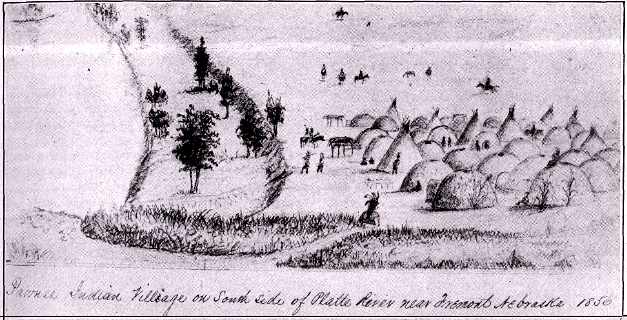
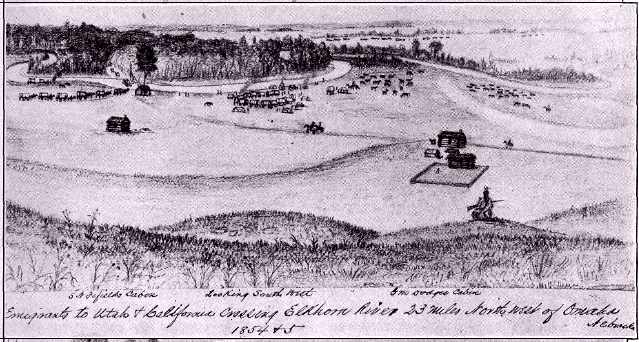
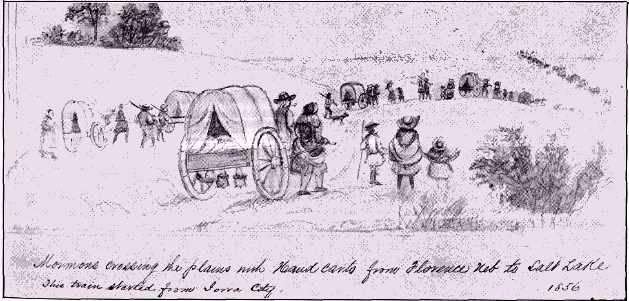
![]()
liant Governor. First the publisher of the most literary paper in the State, "The Advertiser," of Brownville, Robert W. Furnas, assembled the Second Nebraska Regiment and carried the Stars and Stripes through a great part of the West, doing patrol duty. Furnas served in the gubernatorial chair in 1872, and while there issued the first Arbor Day Proclamation on record.
THE FIRST HOMESTEAD IN THE UNITED STATES
Nebraska has the distinction of giving out the first homestead in the United States. The national law was passed in 1862, during the Civil War. At that time Daniel Freeman was a soldier in the Union Army. Given a brief leave Freeman made a quick trip to Nebraska for the purpose of looking over the country for a new home after the rebellion was over. He came to Brownville, which place was crowded with people eager for the land office to throw open its doors. A New Year's Party was being held at the hotel to celebrate the joyous event and while lounging about, Freeman expressed his deep regret that he was obliged to leave the next morning, January 1, 1863, to rejoin his troop, and that Fate was being a little cruel in not giving him enough time to file his claim, since New Year's Day was a legal holiday, and the land office would not open until January 2nd. Everyone there agreed that Freeman should be the first homesteader in the United States and accordingly, a clerk from the land office was persuaded to open the doors a few minutes just after midnight for Daniel Freeman alone. Thus it happened that this young Union Soldier made Homestead Entry Number One. The claim was made along Cub Creek, five miles from Beatrice. To this day it is a place of interest, being still known as the Freeman Homestead.
WHAT THE LEGISLATURE OF 1867 DID
Imagination ran rife with the historical legislature of 1867. Sixteen new counties were formed, sites for their county-seats located and every place was named according to the whims of the legislature members. Of these manufactured counties, Buffalo, Dakota, Cuming, Gage, Lancaster, Saline, York and Pawnee still remain. The counties of Blackbird, Greene, Izard
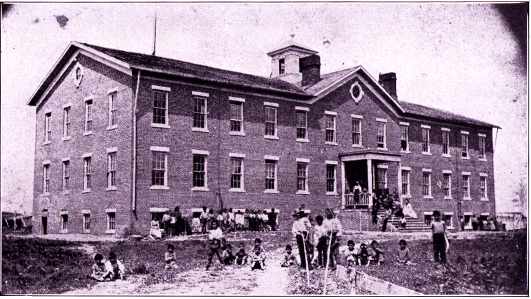
Genoa Indian School. Photo courtesy of the Nebraska Historical Society.
and McNeale never existed, due to the very pertinent fact that no one lived in the territories designated within their boundaries until several years after their manufacture. The counties of Loup and Clay still remain, but have moved many miles west of their original location. The county-seats wandered, too. Clayton, the supposed metropolis of Clay county, failed of birth, as did Hunton of Izard, and Manitou of McNeale county. The town named Columbus, now county-seat of Platte County, should have been called Pawnee, according to the legislature, and instead of Platte, the county's name should have been Loup.
A FEW SMART NEBRASKA LAWYERS
Born in the time when political discussions were burning at white heat, Nebraska soon became flooded with hundreds of lawyers, a great many of whom were a detriment to the profession. A few of its members stand out conspicu-
12
![]()
ously in State history. Augustus Hall was a prominent barrister in the East and served as Chief Justice of the Nebraska territory from 1858 to 1861. Hall County is named for him. John M. Thurston was a corporation lawyer of ability, and a member of the State legislature for many years. In the great Bryan Silver Campaign in 1896, Thurston led the Republican opposition in Nebraska, and this stormy petrel minced words so conclusively that the campaign in Nebraska attracted more attention than that of any other state of the Union. Thurston lost his state overwhelmingly to Bryan but chuckled gleefully when his party's chieftain, McKinley, defeated Bryan for the Presidency. The Bryan Thurston battle is still conceded to be the greatest oratorical war that ever raged in Nebraska. Thurston County is named for him.
A word might be said of another family politically prominent in the early days. Phinias Hitchcock came to Omaha as an attorney, and was a very active man. As delegate to the Republican National Convention in 1860, he helped to nominate Lincoln for the Presidency. He later held many important offices in the new State. His son, Gilbert, followed in his father's footsteps. A newspaper man at heart, the son eventually came to control one of the finest daily papers in the Middle West, the "World-Herald" of Omaha. Hitchcock served as United States Senator from 1912 to 1924 and has long been a leader in the Democratic camp.
NEBRASKA NORMALLY REPUBLICAN
Throughout most of its political career Nebraska, normally, has been intensely Republican. One brilliant man, the late William Jennings Bryan, was able to pry away this State from the Grand Old Party. The World War, too, caused a temporary switch as to the cause of
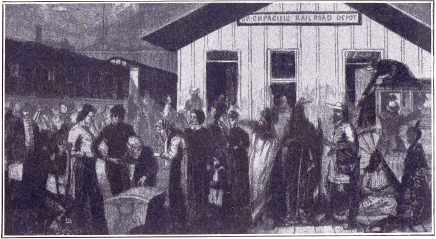
Scene at the Union Pacific Depot in Omaha on September 12, 1868.
this intense Republicanism there is some speculation. The people that came to the New Nebraska Territory in the decade of 1850-1860 were, for the most part, highly incensed at the Supreme Court decision in the famous Dred Scott case, which threw all Territories open to slavery at the wish of any settler. Thus the Territories were badly split, neighbors being strong Abolitionists and others being of the exact opposite opinion. It was populated with people from eastern and northern states and with a foreign-born element possessing a burning love for freedom. Nebraska naturally turned its back on the party then in power, the Democratic, which, it believed, secretly favored slavery. The Civil War, and the principles for which it was fought, were very popular in Nebraska. All of its troops went to the Federal Armies. A Republican President signed the papers giving Nebraska its State Charter. Its early historic legislatures were predominatingly (sic) Republican.
IRRIGATION IN NEBRASKA
The one great pride of Nebraska as a sister state is the unselfish progress it has made in its attempt to bring water to its dry western counties. Politics have never played detrimentally in this very important State development. The Conservation and Survey Division of the University of Nebraska, working in conjunction with engineers from the State Department of Public Works and of the national Department of the Interior through its Reclamation Service have achieved noteworthy success in the extreme west section of Nebraska. The Reclamation Service has labored chiefly in Phelps, Gosper, Kearney, Adams and Franklin Counties. There are over one hundred irrigation projects now in operation in Nebraska, or are about to be. The greatest success has been achieved in and
12
![]()
about Scottsbluff and Gering, where the land is highly irrigated, Mitchell,
Morrill, Bridgeport, Bayard, Ogallala and many other smaller places. A 50-mile
cut-off of the Union Pacific, opening up a new country from Creighton, Nebraska,
to Egbert, Wyoming, has great possibilities through irrigation. This cut-off
was completed in 1928, and already several new towns have sprung up along
the way. The Bureau of Irrigation of the Federal Department of the Interior
has charge of all the regulations pertaining to the water courses.
The vast figure of 400,000 acres in irrigation now included in the North Platte district makes that territory the largest single unit of irrigated land in the world. Originally consisting of very fertile dry soil, the introduction of plenteous water has worked magic in Western Nebraska. Sugar beet growing is the main industry. Commercial potatoes often reach the astounding yield of 400 bushels to the acre. Alfalfa, wheat and corn thrive, and there is a great flourish of cattle-raising. Cheese-making, to be mentioned more fully later on, is increasing rapidly.
THE SUGAR-BEET INDUSTRY
A word needs to be said about Nebraska's newest crop, that of sugar-beet raising. So valuable has the acreage become that there is practically no sale for sugar-beet land. More than 87,000 acres were sown in sugar-beets in 1928, it being by far the largest acreage in the State's history. This crop returned close to 1,048,000 tons of raw beets and were contracted principally by the Great Western Sugar Company at an average price of $7.00 per ton. This corporation operated seven sugar factories in Nebraska, located at Scottsbluff, Gering, Mitchell, Bayard, Lyman, and Grand Island. The beet crop is now the third highest in cash value in the State, and sixth in total value, as compared with other drops. Approximately 2,500,000 bags of sugar were produced in 1928, representing $15,000,000 in value. Based on these figures, Nebraska is the second state in the Union in the production of sugar from beets, being outranked only by Colorado. The raising of sugar-beets affords another valuable addition to Western Nebraska. It is estimated that well over 250,000 head of sheep and 25,000 head of cattle were fed on the tops and pulp of sugar-beets in the Scottsbluff territory alone in 1928.
OTHER CROPS IN THE STATE
Little need be added of the older and well-established industries of Nebraska, for they are well known to every schoolboy and girl. Agriculture holds sway in every section of the State. Corn is Nebraska's leading crop, occupying more than two-thirds of the total cultivated area. In acreage and cash value, corn exceeds all other small grains combined. Three and a half million acres are planted in wheat, about 90 per cent being of the winter variety. Seven million bushels of oats are harvested, and the combined yield of rye and barley exceeds that figure. Where wheat has failed, the ground is usually plowed under and sowed in beans. Fully twenty thousand acres are already sown with commercial beans, principally in western and southern sections of the State. The bean yield is about 30 bushels per acre and ordinarily sells for $3.00 per bushel.
CHEESE MANUFACTURING IN NEBRASKA
In line with other new industries attempted in Nebraska in recent years that of cheese manufacturing has achieved phenomenal success. Scottsbluff was the first city to try commercial cheese shipments. There are now five factories with an annual output of more than 2,000,000 pounds. This cheese is all contracted for by one of the greatest cheese companies in the country, the Kraft-Phenix Cheese Company of Chicago. Within the last five years countless cheese factories have sprung up all over the State. Many of these concerns produce cheese for local consumption, while others specialize in shipments only. The Shell Creek Cheese Factory has been operating profitably for several years. It is purely a Platte County industry, securing all its milk from the county's herds. It is a business that can be justly boasted of, for the commercial tests have proven its product to be above the standard employed in Northern states. Marsh and Marsh, wholesale food jobbers of Omaha, Nebraska, have contracted to dispose of all cheese manufactured at the Shell Creek Cheese Factory. Marsh and Marsh, in taking the cheese manufactured in Platte County, are following a policy of theirs in securing as much Nebraska-made cheese as possible. They are now receiving the entire output of several co-operative and farmers' factories over the State.
THE DEPARTMENT OF ENTOMOLOGY
Much of the success of the State's crops should be given to the department of entomology of the University of Nebraska. Chiefly through the twenty years of labor of the State Entomologist, Myron H. Swenk, the prairie dog, chinch bug and Hessian fly have been fought successfully by the forces sent out to study and combat them. There is no serious bug plague of any kind threatening Nebraska farmers now. Besides the field efficiency of this agricultural service, the entomology department keeps a collection of nearly a half million varieties of insects, as well as a library of over 2,000 volumes
14
![]()
dealing with the subject. These two collections are of the finest of its kind in the United States.
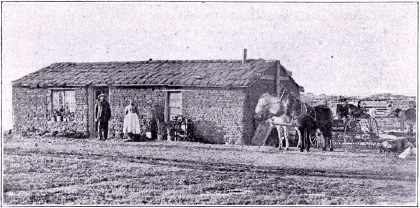
A Nebraska Sod House.
A CITIZEN WHOSE MEMORY NEBRASKA REVERES
An additional $10,000.00 gift by the late Charles H. Morrill, who died in 1928, shortly after his former donation, makes his gifts total $100,000.00 for the perpetuation of the fossils of the prehistoric animals found chiefly in the bad lands of Northwestern Nebraska. This gift of $10,000.00 by Mr. Morrill, a late wealthy Polk County farmer and former regent of the State University, makes possible the extension of the State's Museum for these fossils. The fossil elephants of this region, many of which were unearthed and preserved by E. E. Blackman, State Curator, as well as similar specimens found in the volcanic ash beds about Agate, have grown to large numbers. These gifts of Mr. Morrill are important because through them, Nebraska's State Museum has become one of the finest in the United States. Many special collections are the finest in the world. The fossil beds on Cook Ranch, near Agate, continue to draw scientists from all parts of the world.
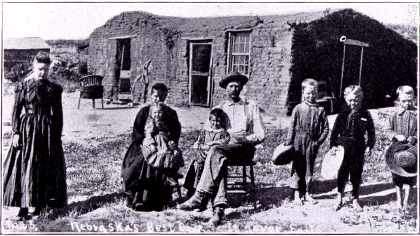
A Sod House on Shell Creek Platte County. Neb.
THE NEW STATE GAME PRESERVE
An important act by the State Legislature of 1927 was the appropriation of $25,000 for the purchase of not less than 4,000 acres of land within the boundaries of Scottsbluff, Banner or Morrill Counties for the erection of a State Game Preserve. This need has been advocated for many years and follows the policy adopted, when a State Bird Reserve was set up a few years ago in Garden County. As funds become available, each species of wild animal, from the buffalo, elk and deer, down to the smallest prairie rodents, known to have frequented Nebraska at the time of the Indian, will be added. So rapidly and deadly has the crack of the hunter's rifle rung through the sandhills, that even in the most remote wild game fastnesses of Nebraska these sportive animals have all but been exterminated. It is in the hope of continuing the almost extinct species of Nebraska game for future generations that the State Game Preserve has been incepted.
THE STORY OF NEBRASKA CATTLE
There is no question about the priority of Nebraska as a cattle state. Since the railroads
15
![]()
came into Nebraska with their branches reaching into every corner of the State,
the cattle-raising industry has assumed great proportions. As early as 1875,
tens of thousands of Texas cattle were driven across the Indian Territory,
now included in the State of Oklahoma. and through Kansas, to the small Nebraska
town of Ogallala, where ample yards and good train service combined to make
possible quick loading and shipping to the Chicago and Eastern markets. Thirty-eight
years ago the Cudahy Packing Company commenced the meat pack-
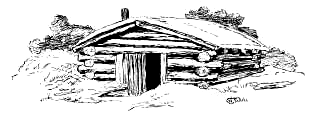
A Nebraska Dug Out. (Drawing by Godfrey Schilz).
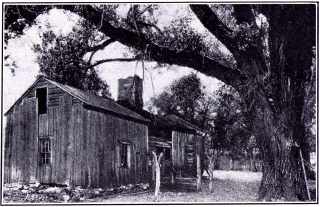
Oldest House in Nebraska, Baptist Mission
for Otoe and Omaha Indians built in 1834.
ing industry in Omaha. Eventually it was followed by Armour and Company; Swift and Company; and, in 1920, by Dold and Company. So great has this business become that Omaha has grown to be the second largest live stock market in the world. The packing plants there do an annual shipping alone well in excess of $9,000,000.
This great stride in interstate and foreign shipping has been made possible with the invention of the railroad refrigerator car. The establishment of the meat packing industry in Omaha caused many great railroad systems to prominently include the Nebraska metropolis. Ten trunk lines, connecting a net-work of 62,577 miles of rail, enter Omaha. Twenty-five states now ship their stock to the Omaha market. As the culmination of years of planning, the Ak-sar-ben* Exposition Company has succeeded in holding the First Annual Live Stock Show, presented in Omaha in the fall of 1928. It is hoped that this yearly event will go a long way towards furthering the live stock business in Nebraska
.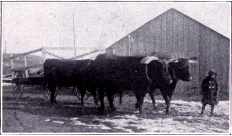
Nebraska Ox Team.
No attempt has been made in these few lines to speak of the long-established industries of Nebraska, the scope of this Sketch being too narrow to give due justice to the march of endeavor in this great commonwealth. Rather, an attempt has been made to trace some of the latest developments in different lines, hoping it will help to create finer impressions of our State upon the readers.
*Nebraska reversed--Ak-sar-ben.
16
![]()
|
|||